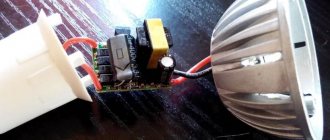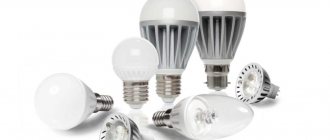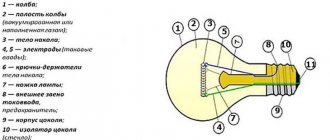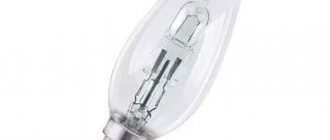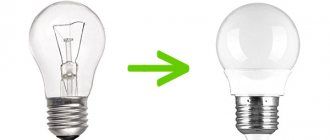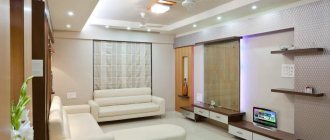Equipping a city apartment, a country house or a private area involves choosing a certain type of lighting that would help not only provide living spaces with comfortable light, but also promote interior and landscape design, as well as ensure safe movement around the site.
Industrially produced LED devices can successfully replace traditional incandescent lamps and therefore are being chosen by an increasing number of country estate owners.
What is the power of the lamp?
Power is the amount of electrical energy consumed by an electrical appliance from the network (watts). It is found as the sum of the powers of the lamps installed in it. The efficiency of the lighting source also depends on them. Incandescent, halogen or compact fluorescent lamps are inferior to LED lamps in this regard. Part of the converted energy they consume from the network is spent not only on lighting, but also on heating (the lamps become hot during operation). The luminous flux of a lamp is measured in lumens. The more energy the device consumes from the network, the brighter the light stream.
The predominant type of surfaces in the interior
Practice shows that the texture and color of objects and materials used in decoration greatly influence the overall illumination in the room. The more matte and dark the surface, the more it absorbs light, and vice versa. The dependence is so strong that only for this indicator manufacturers recommend making an adjustment to the total calculated illumination in the range from 5 to 30 percent.
For example, in the directory of a reputable manufacturer of lighting products you can see the following recommendations for the same room:
| Dark walls, light floors, light ceiling | 4240 lm |
| Light walls, dark floors, light ceiling | 3535 lm |
| Dark walls, dark floors, light ceiling | 4370 lm |
| Light walls, light floors, light ceiling | 3450 lm |
A glossy stretch ceiling (also called “varnish”) can, like a reflector, literally increase the luminous flux in a room, while matte dark canvases cannot reflect valuable lumens.
How to calculate the power of a lamp?
When planning to buy lamps in Minsk, you will be faced with the need to determine the proper level of illumination. Read the data below, which approximately indicates the required power of the light source to effectively illuminate 1m2 of room.
For incandescent lamps:
- bedroom - 10-12 W/m2;
- kitchen, children's room, office, bathroom - 15-18 W/m2;
- living room - 20 W/m2.
Comparison with other lamps: LED 1 W = incandescent 7.5 W, compact fluorescent 1 W = 5.5 W incandescent. By converting the data taking into account new values, types of light bulbs and area of the room, the required power of the lighting device is obtained.
Chandelier or recessed lights
It is not unreasonably believed that mortise and surface-mounted lamps, even when used in large quantities, cannot provide general lighting in a room as effectively as a chandelier. Therefore, lighting manufacturers, when creating their recommendations for choosing the power of a light source, design characteristics of the required lamps by default suggest setting 30-35 percent more than for chandeliers.
For example, to illuminate the same room (according to basic calculations) you need 2750 lumens when using a chandelier, or 3800 lumens when using recessed lamps.
The configuration of the room also plays a role. It would be a clear mistake to rely only on the area of the room. It is clear that in a square-shaped room, one central chandelier will do the job well. But if the room is elongated, then the general lighting may have to be divided into several lighting fixtures. Then it is better to consider the luminous flux as increased - as for overhead/recessed lamps.
Localization, multifunctionality, programmability
Let's not forget that we don't always need a powerful main light that will “cover” the entire room. Sometimes it is not the general background that is of greater value, but the local illumination of individual zones. Here are just a few examples:
- In the hallway it makes sense to install lamps in the area of the mirror and near the closet.
- In the kitchen above the dining table, lighting fixtures on pendants work well, giving an intense light flux in the right place and not casting shadows.
- In a nursery, in addition to a bright ceiling chandelier, a night light and a high-quality table lamp play an important role.
- In the bedroom, along with the warm and diffused light coming from the ceiling, wall sconces have proven themselves well. A night light might also come in handy.
- It is most advisable to equip the living room with two-level lighting. Warm, dim light will be good for relaxation, and bright, cool lighting can be turned on for receiving guests and cleaning. This can be a combination of a chandelier and spotlights, or a multi-position chandelier with a remote control or “two keys”.
- The bathroom requires general light in the form of recessed or surface-mounted lamps, and you will also need additional bright lighting in the mirror area - lighting fixtures are mounted directly on top or on both sides.
How to choose the lamp power?
To calculate power, perform the necessary calculations:
- find the area of the room using the formula: S=AxB;
- take the desired value for the norm of illumination of objects (E). Living room - 200 Lux, kitchen - 150 Lux, children's room - 200 Lux, bathroom - 50 Lux.
- determine the required luminous flux using the formula: Fl = ExSxZ, where Z is the correction factor for the height of the ceiling surface. At a height of 2.5-2.7 m, coefficient Z=1, at a height of 2.7-3m - Z=1.2;
- use data indicating the power of the lamps and the luminous flux they emit. For example, a 20W incandescent lamp produces about 250 Lm, 40W - 400 Lm, 60W - 700 Lm, 75 W - 900 Lm, 100 W - 1200 Lm (1 Lm = 1 Lm/m2). Determine the required number of light sources. Sum up their load and get the required value for your lamp.
How to determine the power of a lamp?
Technical data is indicated on the lamps installed in the lighting device, on its body (LED), and in the documentation. If there are several lamps in the lamp, you need to sum up their load and get the total. Another way to calculate the power of lamps is to measure the illumination level with a lux meter, convert the value into lumens and find the desired indicator taking into account the type of lamps.
Using the tips listed above, you can quickly calculate the power of lamps. Remember that the lighting in the room will be more efficient and uniform if you use not 1-2 lamps of 150 W, but 3-4 lamps of 100 W and 75 W. Lighting level regulation is carried out by replacing light sources that create more or less load in the network, or by connecting a dimmer to the circuit.
To buy lamps in Minsk of the required power, go to the TAM.BY catalog, where we have prepared addresses and phone numbers of stores in the city for you, and companies will delight you with special offers.
If you notice an error in the text of the news, please highlight it and press Ctrl+Enter
Many people prefer LEDs, since the service life of such models and the brightness of the light are several times higher than that of other analogues. In the article we will tell you how to calculate the power of LED lamps required for comfortable lighting of a room, about the features of selecting room illumination, as well as what advantages LED lamps for the home have in comparison with incandescent lamps and what errors may occur when making calculations.
Where is the light source directed?
This factor also applies to the design of the lighting device. Buy a chandelier whose shade faces the ceiling - and you will get calm, relatively uniform lighting, but you will have to choose more powerful lamps.
Point the light downwards and you will make the most of the power of the lamps you purchase.
Scattering angle
Each lamp, each chandelier has its own specific angle of radiation dispersion. This is a unique parameter that directly depends on the width of the lampshade, on the decorative elements present in the lighting fixture, and even on the diameter of the base. The scattering angle determines the area of the predominant light spot on a particular surface. Moreover, keep in mind that the area of this light spot changes with distance.
It is important to know the scattering angle in order to determine whether a particular chandelier/lamp design can provide general illumination in the room or is only suitable for local illumination of individual interior elements.
How to choose the right lighting in a room
Currently, there are standards for room illumination that guide large organizations (industrial premises, offices, hotels, restaurants). To calculate LED lighting in an apartment, you can use these parameters:
- Office – 250 lux;
- Meeting room - 434 suites;
- Garage - 108 suites;
- Reading room - 431 suites;
- Kitchen - 108 suites.
Well, below is a table of the power of different types of lamps for rooms for different purposes.
It is worth noting that room illumination is measured in lux using a special device. However, in residential rooms, the average illumination level is 54 lux.
Basic indicators
We have compared LED lamps and incandescent lamps to clearly demonstrate the main characteristics in action:
- First of all, you need to remember that LED lamps do not flicker. Therefore, their use does not harm human vision;
- Also, no harmful substances are used in their production;
- In addition, LEDs are a non-separable structure that is resistant to strong vibrations and shocks, unlike incandescent lamps;
- LEDs have an average lifespan of 50,000 hours, while incandescent bulbs have an average lifespan of 1,000.
- The design of LEDs does not contain filaments, which contribute to overheating. They often have efficient cooling systems that allow the device to cool down faster.
Other parameters are approximately the same as incandescent lamps. For example, LEDs do not emit mercury vapor, which is not harmful to the environment.
Table of LED lamps and incandescent lamps
Selecting the luminous flux of LED lamps based on the power of incandescent lamps is not as accurate as the first option, but it is much simpler, and many are accustomed to choosing light bulbs in this way. Let's look at the table of correspondence between LED lamps and incandescent lamps in terms of power and lumens:
| Power, Watt | Flow, Lm |
| 20 | 250 |
| 40 | 400 |
| 60 | 700 |
| 75 | 900 |
| 100 | 1200 |
| 150 | 1800 |
| 200 | 2500 |
| 250 | 3600 |
Do not forget that these values are approximate and not very accurate, but you can still use them as a guide. In the previous example, for our room of 30 square meters we needed a 1600 Lm lamp; previously we could have taken two 60 Watt incandescent lamps for such a room. The lighting will be a little less, but everything will fit together.
An even less accurate way to determine the luminous flux of an LED lamp is to compare its power consumption with the power of an incandescent lamp. Less accurate, because here the emitted light flux is influenced more by the quality of the diode than by energy consumption, but the connection is all there, so we can compare:
| Incandescent lamp power, Watt | LED lamp power, Lm |
| 20 | 2-3 |
| 40 | 4-5 |
| 60 | 8-10 |
| 75 | 10-12 |
| 100 | 12-15 |
| 150 | 18-20 |
| 200 | 25-30 |
| 250 | 30-40 |
Don't forget that new technologies are being developed all the time, and over time LED bulbs may use less energy and produce more light.
Power
One of the main reasons why people prefer LEDs is the low energy consumption compared to incandescent lamps.
So, on average, the rated power of incandescent lamps ranges from 40 to 100 watts. However, if you look at the characteristics of LEDs, this figure is 10 times lower. Thus, if you want to reduce the price tag for paying for electricity, then it is worth purchasing an LED lamp that will serve you for many years.
There is also a table of LED powers, which is worth familiarizing yourself with when making calculations.
Calculation of the optimal power of LED lamps
It is recommended to calculate the optimal lighting power when repairing and installing lamps. So, you will always know what power you need to purchase lamps and how long they will last. In the event that you need to know how much power LEDs should have in one room, you need to know certain parameters:
- Light level;
- Area of one room;
- Number of lamps to be installed;
- Light flow;
- Room illumination level.
To calculate the luminous flux that comes from one lamp, you must use the following formula:
If you need to find out the level of illumination per square meter, then use the formula:
LED lamp power and other characteristics
Using LED lamps will significantly reduce energy costs. A simple calculation based on lighting standards and the choice of certain lighting parameters, for example, in a kitchen room, will prove this.
So the main parameters of lamps of various types are:
- power, measured in Watts, that is, the amount of energy consumed by the lighting element;
- color rendering - the shade of light at the radiation source, measured in Kelvin;
- luminous flux - the amount of light emitted by a lamp, which shows the efficiency of the source,
since the higher this characteristic, the more efficiently the device uses energy.
Thus, tungsten lamps with a power of 40 W have a light output of 10.4 lm/W,
fluorescent - 84 lm/W,
LED lamp with a power of 40W - 86 lm/W.
Errors in calculations
During renovation work, the plans of the owners of the premises often include replacing conventional incandescent lamps with LED lamps, after which the illumination level may decrease several times.
The reason for this can be a huge number of factors, which include:
- Use of wallpaper, laminate, linoleum in dark shades;
- Incorrect determination of LED color temperature;
- Installation of a stretch ceiling with a matte effect.
Therefore, when determining illumination, it is necessary to take into account the coefficients of the main surfaces of the room - the ceiling, walls and floor:
- 70% – white;
- 50% – light color;
- 30% – gray color;
- 10% – dark color;
- 0% – black color.
To do this, calculate the overall reflectance:
· General K.O.= K.O. ceiling+K.O.walls+K.O.floor)/3.
Once the result has been obtained, it must be multiplied by the previously calculated luminous flux.




